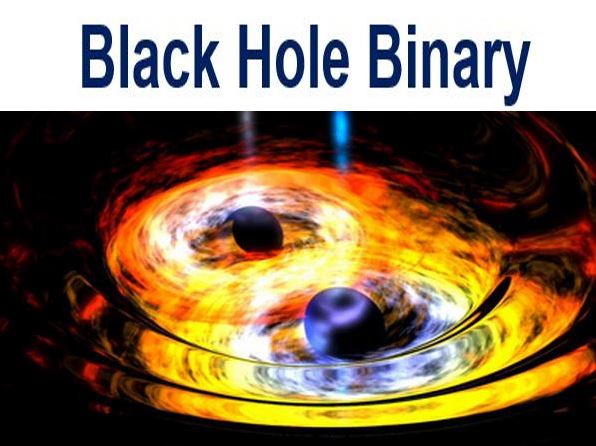Scientists believe two supermassive black holes will form a ‘binary’ – two black holes bound to each other by their gravitational pull – as two galaxies reach the final stages of merging. University of Maryland astronomers say they have found direct evidence of a pulsing quasar, which may support the existence of black hole binaries.
Co-author, Suvi Gezari, assistant professor of astronomy at the University of Maryland, said:
“We believe we have observed two supermassive black holes in closer proximity than ever before. This pair of black holes may be so close together that they are emitting gravitational waves, which were predicted by Einstein’s theory of general relativity.”

Artist’s conception of two black holes entwined in a gravitational tango. (Credit: NASA)
Prof. Gezari and colleagues published their findings in Astrophysical Journal Letters (citation below). They say their discovery could provide insight into how often black holes get near enough to form a gravitationally bound binary and eventually merge into one.
Typically, black holes devour matter, which accelerates and heats up, emitting electromagnetic energy and creating some of the most spectacular light shows in the universe, known as quasars.
When two black holes orbit each other as a binary, they absorb matter cyclically, which leads theorists to predict that the binary’s quasar would respond by periodically dimming and brightening.
Prof. Gezari and colleagues carried out a systematic search for variable quasars using the Rapid Response System (Pan-STARRS1) Medium Deep Survey and the Panoramic Survey Telescope.
The telescope imaged the same patch of sky once every three days and gathered hundreds of data points for each object over a period of four years.
Within those data, the scientists found PSO J334.2028+01.4075, which is a huge black hole of nearly 10 billion solar masses. It emits a periodic optical signal that repeats every 542 days.
Unusual quasar signal
Most quasars light curves do not have a rhythm, which means this quasar’s signal was unusual. To confirm their finding, the team performed rigorous calculations and simulations and examined further data, including spectroscopic data from the FIRST Bright Quasar Survey and photometric data from the Catalina Real-Time Transient Survey.
First author, Tingting Liu, a UMD astronomy graduate student, said:
“The discovery of a compact binary candidate supermassive black hole system like PSO J334.2028+01.4075, which appears to be at such close orbital separation, adds to our limited knowledge of the end stages of the merger between supermassive black holes.”
The team says it plans to carry on searching for new variable quasars. Their search could be aided by the Large Synoptic Survey Telescope in 2023, which is expected to survey a much greater area and could potentially pinpoint the locations of thousands of these merging supermassive black holes in the universe.
Liu said:
“These telescopes allow us to watch a movie of how these systems evolve. What’s really cool is that we may be able to watch the orbital separation of these supermassive black holes get smaller and smaller until they merge.”
The study was funded by the Pan-STARRS1 Science Consortium and National Science Foundation.
Citation: “A Periodically Varying Luminous Quasar at z = 2 from the Pan-STARRS1 Medium Deep Survey: A Candidate Supermassive Black Hole Binary in the Gravitational Wave-driven Regime,” Tingting Liu, Suvi Gezari, Sebastien Heinis, Eugene A. Magnier, William S. Burgett, Kenneth Chambers, Heather Flewelling, Mark Huber, Klaus W. Hodapp, Nicholas Kaiser, Rolf-Peter Kudritzki, John L. Tonry, Richard J. Wainscoat, and Christopher Waters. Astrophysical Journal Letters. Published online 14 April 14, 2015. DOI: 10.1088/2041-8205/803/2/L16.
